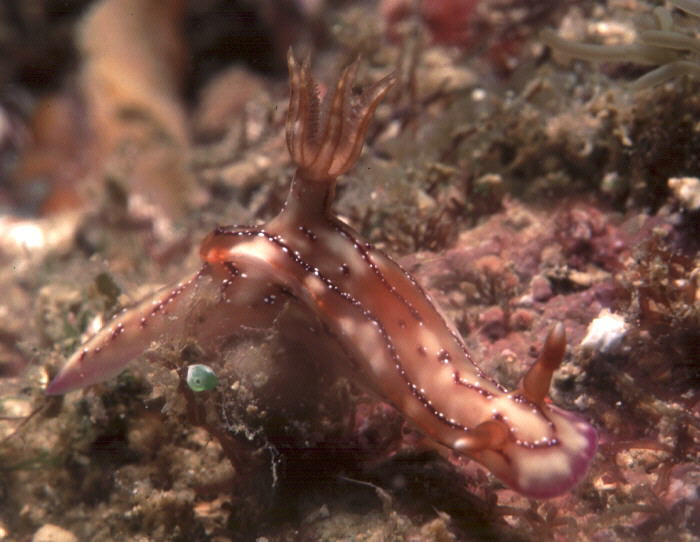 |
Hypselodoris krakatoa
Photo taken by Webmaster at Batangas, Philippines, April 1998
Hypselodoris krakatoa Gosliner & Johnson, 1999
Well I think we need to get back to introducing all those great Hypselodorids that Terry and Rebecca described last fall. This week I'd like you to meet Hypselodoris krakatoa. It was named to recognize the similarity between the Indonesian volcano, Krakatoa, that exploded on August 26, 1883, and the volcano-like shape of the gill sheath which is elevated from the rest of the notum, and the gills resembling the huge cataclysmic eruption of smoke and burning lava reaching into the sky. Wow, that kinda gets the heart pumping!
The body is long with a high profile. The posterior, near the base of this slug volcanic gill is higher than the rest of the body. The mantle has a complex color pattern over the surface of the notum. The body is yellowish brown with darker brown patches over the body surface, forming a irregular figure-eight pattern. The arrangement of these patches is variable. There are two parallel black lines that begin anterior to the rhinophores and end and join posterior to the gills. These lines are overlaid by scattered white or light blue spots. Between these lines there is a medial black line which may be complete or broken. It too has a series of whitish spots. Other isolated and scattered black lines may occur elsewhere on the dorsal surface. The mantle margin around the head and foot is light purple. The rhinophores is rusty-brown with opaque white apical spots. The seven simply pinnate gills are yellowish brown with rust-red tips. Hypselodoris reidi presented earlier as BOW #167 also has a similar "volcano" gill like arrangement.
This species, with its pyrotechnic gills, reaches 55 mm in length and is
known from Okinawa, the Philippines, Indonesia and Papua New Guinea.
Danville, Calif
Feb. 2000
Citation
Terrence M. Gosliner and Rebecca F. Johnson, 1999. Phylogeny of
Hyselodoris (Nudibranchia: Chromodorididae) with a review of the
monophyletic clade of Indo-Pacific species, including descriptions of
twelve new species. Zool. Journ. Linnean Soc. 125:1-114, with 62
figures.
Taxonomic information courtesy of Dave Behrens

David W. Behrens
Author:
Pacific Coast Nudibranchs
Send Dave mail at seachalleng@earthlink.net
|
